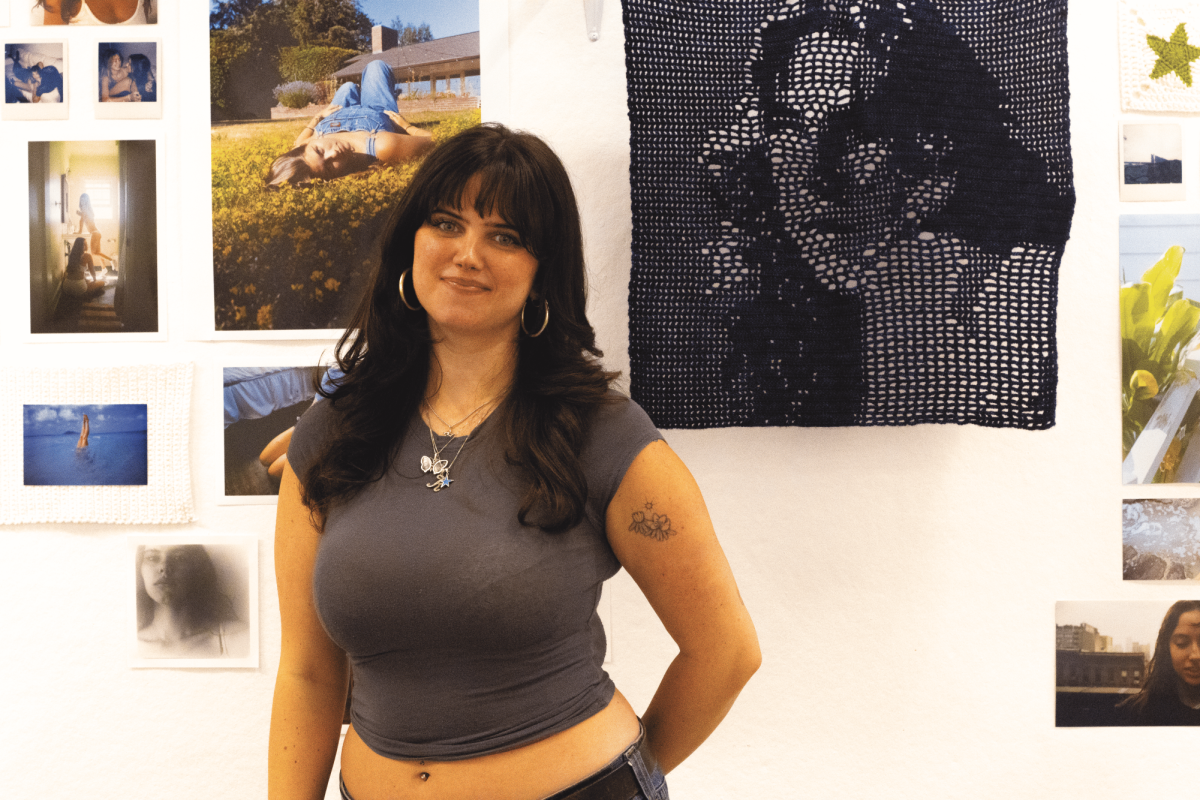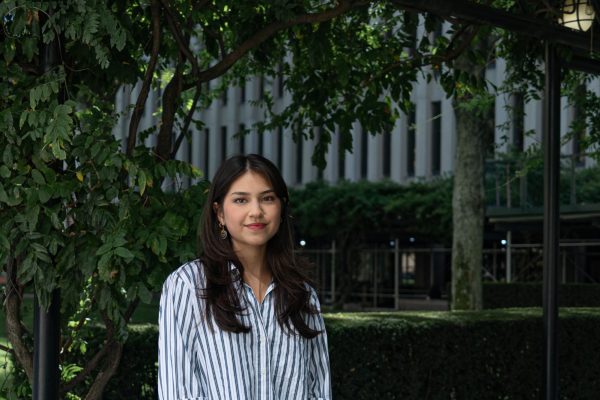On March 28, a crowd gathered in Lipani Gallery to celebrate Lucy Duckett and Kenzie Roberts, two Fordham seniors presenting their thesis projects for the visual arts program from March 25 to April 8.
Duckett, Fordham College at Lincoln Center (FCLC) ’25, and Roberts, FCLC ’25, completed their theses independently, and their work involved different narratives. However, when exhibited in the same space, a visual synergy suffused the room. Photos taken by both artists felt like memories — flashes of a never-ending summer, and of sheltering within it.
In one of Roberts’ images, a young woman lies in a shallow pool of water while waves crash further down the beach. Duckett showcased a similarly composed photo — a person half-submerged in the reedy waters off an embankment, their head tilted to the sky.
Duckett’s thesis, “En Gallop,” is named after a song by folk singer Joanna Newsom. Duckett’s photos reflect the time she spent at independently-run “transgender healing farms” in the rural midwest, where she lived and bonded with the people who operate them. The first town she visited had a population of 973.
“En Gallop” feels like the first sign of spring; the miracle of beginning anew.
“I feel like being transgender in the middle of nowhere, in a town of less than a thousand people, like ‘Trump-land,’ like ‘MAGA-land’ — that’s terrifying,” she said. “I think that’s what drew me in.”
Duckett found a directory of LGBTQ+ farming projects last summer and started cold-pitching her thesis. After numerous dead-ends, she finally heard from a few farmsteaders open to hosting her. Fordham awarded Duckett an undergraduate research grant to cover her expenses, and she set out for middle America.
In Hesperia, Michigan, Duckett camped on the land and met folks there who aim to create a community for transgender and queer people. In Viroqua, Wisconsin, she befriended a flower farmer named Rufus, whose portrait “Rufus Buzzes Hair” is a highlight of the collection. The photo shows Rufus standing shirtless in their front yard, shaving their head with an electric razor.
“En Gallop” feels like the first sign of spring; the miracle of beginning anew. The sparse pastoral backdrop gives the series a dreamy quality. Yet impermanence pervades the collection. One image shows a tiny church in disrepair, the remainder of a faithful community that no longer exists.
I contemplated the significance of rural havens for a group of people who face increasing threats to their access to medical care, the perversion of their identity in mainstream media and overt erasure by the government. Is it exile? Is it paradise?
For Duckett, it’s a community persisting in unexpected places. Her time on the farms opened her eyes to purposeful living that defied her judgment.
“I always thought that I needed to be in a city with people and settled down,” she said. “Life is not what you expect it to be. These people did not expect to be what they’re doing … Community is everywhere, it really is.”
Similarly poignant, but differing in subject matter, “Fibers” by Kenzie Roberts centers on female kinship and the preservation of youth. The frameless images range in size from polaroids to large prints and are displayed on the gallery walls in neat clusters.
Roberts created several prominent pieces of fiber art to accompany her photographs. Two are large-scale monochrome crochet portraits, feats of craftsmanship that Roberts takes great pride in. She made the first over the course of three weeks, and the second one in three restless days.
When a professor pushed her to develop a cohesive narrative for them, the undertaking felt like a natural extension of her artistic gaze.
Highlighting the people in her life is ordinary for Roberts. Before her thesis, she regularly photographed her friends and family. When a professor pushed her to develop a cohesive narrative for them, the undertaking felt like a natural extension of her artistic gaze. She took more photos of loved ones in Hawaii, South Carolina and her home in Seattle, among other places.
The photos that comprise “Fibers” brim with tenderness and light. Between snapshots of sun-drenched flower beds, interior scenes and ephemera, there are girls. They lounge by open windows and on sofa beds, entangled in each other’s limbs. There is freedom in the way they wield their bodies and bare their skin. The girls look directly into the camera lens.
Those images are the ones Roberts likes most. She designed her exhibition with those intimate moments of connection in mind — which is why she included smaller photo sizes that require close-up viewing.
Getting the right shot was intuitive for Roberts. She often captured them in familiar environments like their bedrooms.
“I didn’t want to put someone in a room and have it be inauthentic and weird. I wanted them to be comfortable in the setting and just do what they wanted,” she said.
Roberts’ process reflects her higher objective for “Fibers,” which she said is to memorialize this time in her life through art. Looking at her photos depicting female friendship, I felt a sense of displaced nostalgia, like I was attaching my memories to someone else’s.
“En Gallop” and “Fibers” both closed on April 8 in the Lipani Gallery.


